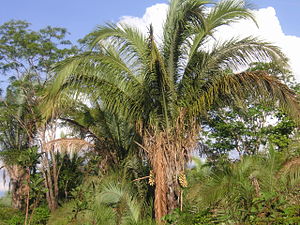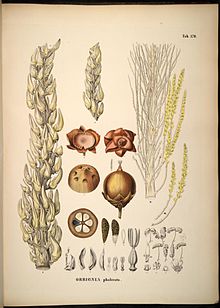Babassu palm
| Babassu palm | ||||||||||||
|---|---|---|---|---|---|---|---|---|---|---|---|---|

Babassu palm ( Attalea speciosa ) |
||||||||||||
| Systematics | ||||||||||||
|
||||||||||||
| Scientific name | ||||||||||||
| Attalea speciosa | ||||||||||||
| Mart. ex explos. |

The babassu palm ( Attalea speciosa ), also known as Cusi palm , is a South American palm species from whose seeds babassu oil is obtained. The Cohune palm ( Attalea cohune ) is similar from the seeds of which vegetable fat is obtained.
description
Vegetative characteristics
Attalea speciosa is a single- stemmed , monozoic palm that can reach a height of 30 m and a trunk diameter of 20–50 cm. The palm can live up to 200 years and bears fruit for the first time after 8-10 years. The 12-20 leaves are arranged on the crown, they are six to nine meters long and protrude upwards and outwards at an acute angle, the tips are arched downwards and often twisted. The petiole is up to 1.5-2 meters long, the leaves carry 150 or more 30 to 70 cm long and 3-4 cm wide, dull green, lineallanzettliche, simple folded leaflets along the rachis .
Generative characteristics
The one to eight, up to one meter or longer stalked inflorescences are pendulous and either purely male, female or bisexual (androgynous). They reach lengths of one to two meters. There is a cover sheet about one meter long . In the bud stage, the inflorescences are surrounded by the approximately two meters long and 20 cm wide, boat-shaped, long-pointed and woody bract . Male inflorescences have up to 400 side branches, each with 15–100 flowers. The male flowers are whitish-yellowish, they have 12–24 stamens with twisted anthers. The female inflorescences bear female and sterile male flowers. The bisexual inflorescences have slightly more side branches, each has one or two (rarely three) female flowers and one or more male flowers, which often do not develop fully.
The beak-pointed fruit is an ellipsoidal stone fruit 6–15 cm long and 4–10 cm wide. The hazelnut brown exocarp is fibrous and up to 4 mm thick, the fleshy, dry mesocarp up to 10 mm thick is fibrous to floury, it contains a lot of starch , the dark brown endocarp is extremely hard, woody and up to 1.5 cm thick, it is about 3.5-7.5 cm in diameter. The fruits weigh around 80–250 grams. Inside there are one to eight (up to eleven) flattened, ellipsoidal seeds, with a thin, dark brown seed coat , 2–5 cm long and 1–2 cm thick. The individual kernels weigh around 3–9 grams. They have an oily, white endosperm which contains approx. 60–70% fat and approx. 7% protein. The fruit clusters bear 100–600 fruits and can weigh up to 90 kg. On the outside of the shell (exocarp) there are brown, powdery scales. The seeds make up about 6-10% of the fruit weight. When the fruits first came to England in 1867, they could not be cracked, so they were thrown into the sea.
Main pollinators are beetles ( Mystrops ; beetles Nitidulidae), ( Phyllotrox ; Curculionoidea ) and bees ( Trigona ). In the open landscape, the palm is also pollinated by wind . The spreading of the seeds occurs zoochor by capuchin monkeys , Südamazonische red squirrels , rodents ( Agoutis , Green acouchi , Brown agouti Dasyprocta variegata u. A.), Wild boar , Peccaries (Pekaris), also Schakuhühner ( Pipile u) and parrots. a.
Distribution and locations
The babassu palm is native to the southern area of the Amazon basin from the Atlantic to Bolivia and extends in the north over the eastern and central Amazon to Guyana and Suriname . Most of the stocks are, however, south of the Amazon. In Maranhão and Piauí there are Babassu stocks with up to 10,000 palms per hectare. These are mainly young plants that settle particularly easily on disturbed locations. This so-called Babassu zone extends over around 150,000 km 2 in the southeast of the Amazon region, often at the transition from the forest to the savannah.
The babassu palm is relatively undemanding in terms of site conditions. Usually it grows in good soil with high rainfall. It also occurs in drier areas, but here more along the rivers. However, it cannot tolerate floods. An annual rainfall of 1500 to 2500 mm is considered optimal for growth.
use
Babassu palms are less cultivated in plantations, but natural stocks are promoted and used. Young, dense stands are thinned out by harvesting palm hearts , as the palm trees die. Older and all-male palms are also eliminated.
The Quebradeiras de Coco Babaçu (collectors of the Babassu fruit) are traditional communities in Brazil that explicitly base their collective identity on the economic activity of women. Their collection areas in Maranhão , Pará , Piauí and Tocantins have been increasingly fenced off since 1950. They therefore demanded free access to the Babaçu areas "Terra Babaçu livre" (Free Babaçu Land). Some municipal laws today guarantee free access (Lei Babaçu Livre). As a recognized traditional community , legal protection is extended by a decree. Direct marketing of Babassu products; Babassu oil, milk (mix the crushed kernels with water), flour (from the mesocarp), soap, baskets, etc. a. is currently being intensified through cooperatives.
The exocarp (approx. 10–15%) serves as fuel, the mesocarp (approx. 20–25%) is used for industrial starch, glucose and alcohol or cattle feed, the endocarp (approx. 55–62%) is charred or as Substrate used for hydroponics . The seeds can be eaten raw or cooked, they also serve as parrot food. Broken kernels are fed to pigs because they are unsuitable for oil production because the fat quickly goes rancid.
The inflorescence stalk provides a sugary liquid that becomes alcoholic during fermentation and is consumed by the Indians. In the north of Brazil, the babassu is used to make palm wine . The stumps that are left after harvest are hollowed out and the juice that accumulates in the cave is allowed to ferment.
Taxonomy
The babassu palm is now known as Attalea speciosa . A frequently used synonym is Orbignya speciosa , but there are several other synonyms.
literature
- J. Janick, RE Paull: The Encyclopedia of Fruit & Nuts. Oxford University Press, 2008, ISBN 978-0-85199-638-7 , pp. 92 f.
- Elsa Franke, Reinhard Lieberei, Christoph Reisdorff: Useful plants. 8th edition, Thieme, 2012, ISBN 978-3-13-530408-3 , p. 135.
- Food and Fruit-bearing Forest Species. 3: Examples from Latin America , FAO Forestry Paper 44/3, 1986, ISBN 92-5-102372-7 , pp. 209 ff.
Web links
- Attalea speciosa from Useful Tropical Plants, accessed November 22, 2017.
Individual evidence
- ↑ a b Michael Bockisch: Fats and Oils Handbook. AOCS Press, 1998, ISBN 978-0-9818936-0-0 , pp. 294-301.
- ↑ JG Wessels Boer: The Indigenous Palms of Suriname. Brill, 1965, p. 164, limited preview in the Google book search.
- ^ A b G. E. Wickens: Edible Nuts. FAO, 1995, ISBN 92-5-103748-5 , pp. 91-95, online (PDF; 13.8 MB), at fao.org, accessed on November 22, 2017.
- ^ J. Smartt, Emmanuel Nwokolo: Food and Feed from Legumes and Oilseeds. Chapman & Hall, 1996, ISBN 0-41245-930-2 , Springer, ISBN 978-1-4613-8050-4 , p. 302.
- ^ Francis Kahn, Jean-Jacques de Granville: Palms in Forest Ecosystems of Amazonia. Springer, 1992, ISBN 978-3-642-76854-5 , p. 147.
- ↑ a b Umberto Quattrocchi: CRC World Dictionary of Palms. CRC Press, Boca Raton 2017, ISBN 978-1-351-65149-3 .
- ↑ Fight for the Coconut. In: FAZ . from September 29, 2015.
- ↑ Dieter Gawora, Maria Helena de Souza Ide, Romulo Soares Barbosa (ed.), Mirja Annawald (transl.): Traditional peoples and communities in Brazil. Latin America Documentation Center, Kassel University Press, Kassel 2011, ISBN 978-3-86219-150-5 , online (PDF, 7.2 MB), at uni-kassel.de, accessed on August 30, 2016.
- ↑ Brasilicum 238/239 , Freiburg 2015, ISSN 2199-7594 p. 49, online (PDF; 5.3 MB), on kooperation-brasilien.org, accessed on November 22, 2017.
- ^ Forestry and Food Security. FAO, 1989, 1991, 1996, ISBN 92-5-102847-8 , p. 42.
- ↑ Attalea speciosa in the World Checklist of Selected Plant Families , accessed October 29, 2009.

